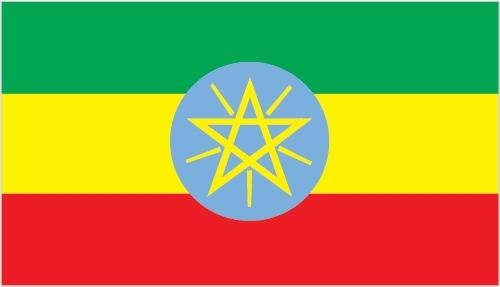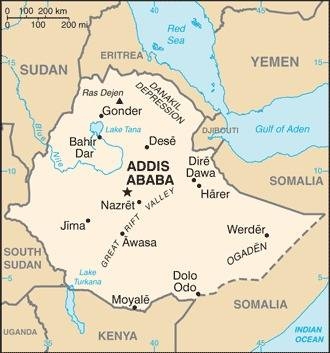196 Ethiopia

Three equal horizontal bands of green (top), yellow, and red, with a yellow pentagram and single yellow rays emanating from the angles between the points on a light blue disk centered on the three bands. Green represents hope and the fertility of the land, yellow symbolizes justice and harmony, while red stands for sacrifice and heroism in the defense of the land. The blue of the disk symbolizes peace and the pentagram represents the unity and equality of the nationalities and peoples of Ethiopia.
Flag courtesy of the CIA World Factbook

Map courtesy of the CIA World Factbook

The rock-hewn Church of Saint George in Lalibela. Ethiopia was one of the earliest nations to adopt Christianity in the first half of the 4th century. In the 12th and 13th centuries, in a mountainous region now called Lalibela, eleven medieval monolithic churches were carved out of rock. The layout and names of the major buildings in Lalibela are widely accepted to be a symbolic representation of Jerusalem. The churches were declared a UNESCO World Heritage Site in 1978.
Photo courtesy of the CIA World Factbook
Government
According to Britannica, Ethiopia’s ancient system of feudal government experienced significant changes under Haile Selassie I (reigned 1930–74), who carefully grafted onto the traditional governing institutions a weak parliament of appointed and elected legislators, a judiciary with modernized civil and criminal codes and a hierarchy of courts, and an executive cabinet of ministers headed by a prime minister but answerable to the emperor. The Derg took power in 1974 and promised to bring revolutionary change to Ethiopia. Promulgating itself as the Provisional Military Administrative Council (PMAC) and later as the Workers’ Party of Ethiopia (WPE), the Derg instituted a Soviet-style government with a state president and a house of deputies that were answerable to a revolutionary council with a politburo at the top. In May 1991 the Ethiopian People’s Revolutionary Democratic Front (EPRDF) entered the capital. The EPRDF introduced a temporary constitution called the National Charter, created an 87-member assembly known as the State Council, and proceeded to form a cabinet for the Transitional Government of Ethiopia (TGE). The TGE endorsed the secession of Eritrea, realigned provincial boundaries in an attempt to create ethnic homogenates, demobilized the national armed forces, and suspended the courts and enforcing agencies.
The TGE was replaced by the Federal Democratic Republic of Ethiopia, which was established by a constitution adopted in 1994 but not promulgated until after the federal elections of 1995. The new constitution stated that “sovereignty resides in the nations, nationalities and peoples of Ethiopia” rather than in the people as a whole and granted each nation, nationality, or people rights of self-determination, up to and including secession.
Under the constitution the government is a republic with a powerful prime minister as head of government and a titular president as head of state. The legislature is bicameral, with a House of Peoples’ Representatives (lower chamber) and a House of the Federation (upper chamber). Members of the former are directly elected to a five-year term, while members of the latter, who also serve a five-year term, can be either selected by state councils or directly elected if state councils exercise the option to hold an election. The ruling party in the House of Peoples’ Representatives designates a prime minister. It also nominates a candidate for the presidency, who is then subject to a vote by both legislative houses. The president serves a six-year term.
The 1994 constitution created ethnically based kililoch (regional states; singular kilil), Afar, Amhara, Benishangul Gumuz, Gambella, Harari, Oromia, Somali, Tigray, and Southern Nations, Nationalities and People (SNNP), and two self-governing administrations, the cities of Addis Ababa and Dire Dawa. Each regional state is headed by a president elected by the state council, and the cities are headed by a chairman. Voters in a 2019 referendum overwhelmingly supported the creation of a new kilil for the Sidamo people, which would be split from the SNNP kilil.
The constitution provides for an independent judiciary. The federal court system is headed by the Supreme Court; there are also a High Court and Courts of First Instance. Each state has a parallel court system.
Civil / National Aviation Authority (CAA/NAA)
The Ethiopian Civil Aviation Authority (ECAA) mission is to enable the public get access to reliable air transport service by ensuring aviation safety and security through effective regulatory function, environmental protection, provision of air navigation services, by strengthening global cooperation and partnership.
Airspace
SkyVector – Google Maps – ADS-B Exchange
ICAO countries publish an Aeronautical Information Publication (AIP). This document is divided into three parts: General (GEN), En Route (ENR) and Aerodromes (AD). ENR 1.4 details the types of airspace classes they chose to adopt from classes A through G. Ethiopia AIP
Drone Regulations
Advanced Air Mobility (AAM)
Short Essay Questions
Question 1
You have been hired by a Drone Startup Company. Your boss has immediately assigned this job to you.
They need you to prepare a one-page memo detailing the legalities of using a drone to film in Lalibela, pictured above.
They need you to mention any national laws and local ordinances.
They specifically want to know what airspace you will be operating in and whether or not you need an airspace authorization.
Does it matter whether or not you are a citizen of the country?
Lastly, there is a bonus for you if, as you scroll through this chapter, you find any typos or broken links!
Question 2
Do you need a certificate to fly UAS?
If so, how do you obtain one?
Are there fees associated with this?
If so, how much?
Question 3
May you operate beyond visual line of sight?
If so, what procedures must you follow?
Question 4
Does the country have UAM/AAM laws? If so, describe, citing the exact law.
Question 5
Are you aware of any new laws or policies not mentioned above? If so, describe, citing the exact law or policy.

